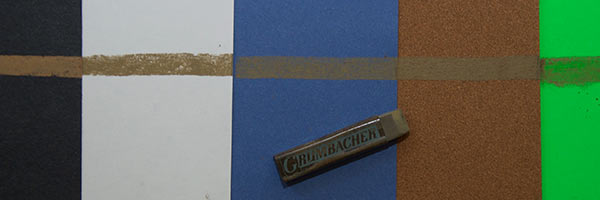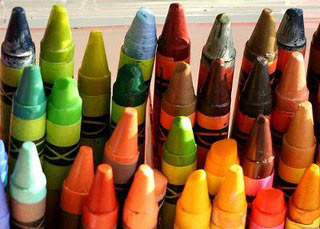I was on a date once where I found myself skiing on a very bright sunny day. As we were heading up a ski lift, my companion asked me to give him an art lesson since he was an engineer and knew I was an artist. I responded by looking down on a row of pine trees that were below us and were casting beautiful shadows from the sun. I said, “Ok- what color are the shadows?” He seemed confident when he answered, “They are grey”. I said, “ok, this is your first art lesson… grey is not a color”.

When I say that grey is not a color, I mean that- it doesn’t exist. Artists frequently talk about neutral colors, and then we think of “greys.” But I don’t like to think like that- and there are many artists that believe there is no such thing as a “neutral color”. I am one of them. We believe that there is always a color dominance to any color mixture or even any “greyed-out” stick.
Here is why…..

Above I picked out in pastel a “grey stick” and put one straight line across these different papers. And something amazing happened! The exact same stick appears to change color and value as it goes across the different surfaces. (as if color wasn’t hard enough). The color looks orange-ish on black paper, darker yellow on the white, orange-y on the blue paper and olive green on the brown paper. Then it looks like a darker green altogether on the lime-green paper. Look at the clear difference between the first mark on the black paper and the last one on the lime paper. So depending on its surrounding colors and values, a color may even appear to be thrown into a completely different hue family! Mind blown.
Ever pick up a stick and think it is green and then it looks pinkish on your painting? This weird law of nature is called color relativity and it is why I don’t believe in formulas for painting skin tones or trees, or whatever.
Every color is relative to it’s surroundings…….
On a color wheel, there are 12 color hues or “families.” ( I know we all learned the “7 colors of the rainbow” as a kid, but there are actually 12…). And “Grey” is not one of them. Grey tends to represent the very “dirtied” versions of the twelve, but it doesn’t have it’s own color family. (Artists call this type of color low-chroma) In my workshops, when someone asks should they place “grey” into a painting, I say “Which grey? A purple-grey, a blue-grey, an orange-grey? And depending on where it is placed, or what colors are next to it, it may change color completely.

So the next time you look at a box of crayons and admire all the pretty colors, remember the little “grey” crayon. It might surprise you with its amazing hidden color!
